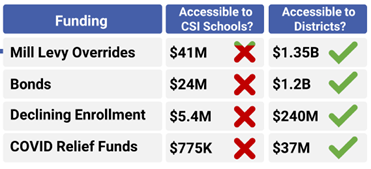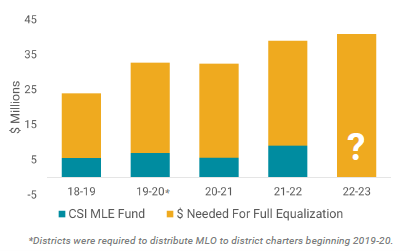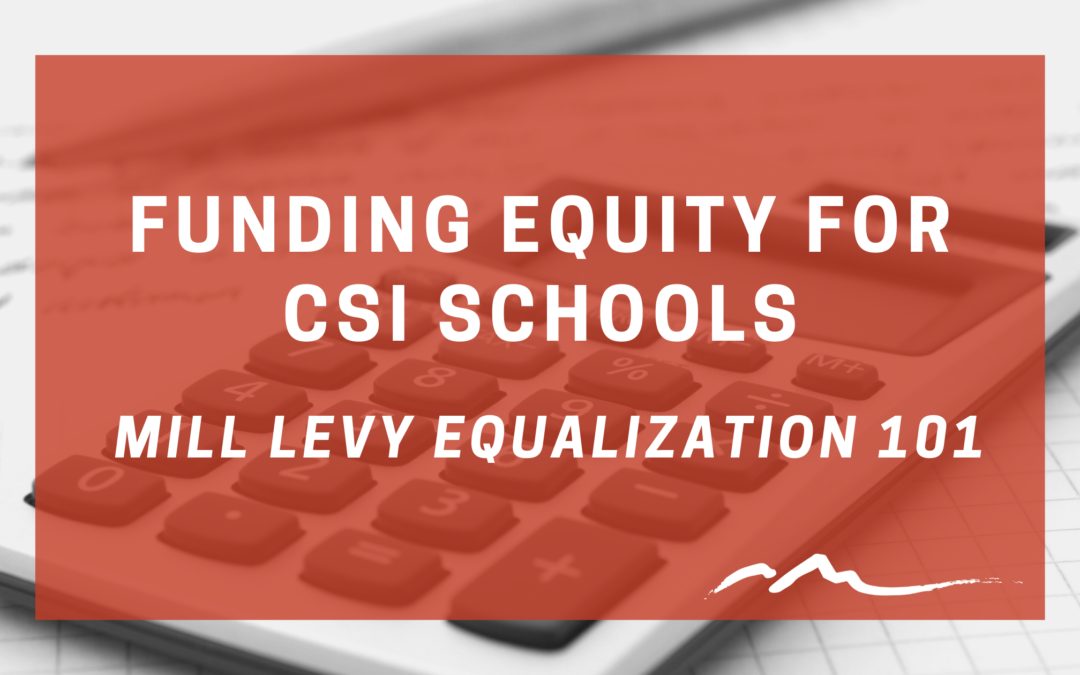I spend a great deal of my time educating our partners, legislators, and the community about funding inequities for CSI schools.
Funding Inequities for CSI Schools
Despite being part of the public education system for over 15 years, CSI students continue to face significant funding inequities when compared to their traditional public school peers. In fact,
Students attending CSI schools receive 25% less funding on average than students attending district schools.
CSI schools do not have access to many of the funding streams currently available to districts. The table below outlines some of those funding streams:

Although there are numerous funding disparities, CSI has focused its efforts on securing funding parity in one funding stream that impacts the most CSI schools: mill levy override equalization.
Mill Levy Equalization
For those looking for some foundational information to share with your community and stakeholders on mill levy equalization (or just to learn more), here’s a breakdown of the issue and how it’s been addressed over the last five years.
And, for those who prefer a verbal description, check out this podcast I participated in with CSI Board Member Brenda Dickhoner to talk about mill levy equalization for CSI schools.
What is a Mill Levy Override?
A mill levy override asks voters to approve an increase in the number of mills they pay for property tax, which allows for the collection of additional property tax dollars.
How Significant are Mill Levy Overrides?
Mill levy overrides will generate over $1.3B of local property tax revenue in Fiscal Year 2021-22 for use by public schools across the state.
What Did HB 17-1375 Do for Charter Schools?
During the 2017 legislative session, there was a concerted, bipartisan effort to ensure that all public school children have access to an equitable share of public school funds, regardless of what type of public school they attend. As a result, House Bill 17-1375 was signed into law on June 2, 2017.
HB 17-1375 requires school districts to distribute funding they receive from local property taxes generated by Mill Levy Overrides (MLO) on an equal per pupil basis to district charter schools beginning in the 2019-2020 year.
What about CSI Schools?
Out of recognition that schools authorized by the Colorado Charter School Institute (CSI) have no access to local tax revenue, the bill also created the Mill Levy Equalization Fund. This Fund is a mechanism for providing equitable funding to CSI students.
While the bill created the mechanism for funding, no dollars were immediately allocated to the CSI fund, resulting in a persistent funding gap for the 20,000+ public school children that are attending CSI schools.
Advocating for Mill Levy Equalization
Each year, CSI has worked with the Governor’s Office and the Joint Budget Committee to secure funding for the CSI Mill Levy Equalization Fund.
While we have generally seen upward movement in the Fund, there is still a long way to go. While the Fund received $9M for the 2021-22 year, another $32M would be required to achieve parity with district counterparts.

We continue to focus on Mill Levy Equalization. Without parity, CSI students, teachers, and communities will continue working towards the same academic standards but will do so with fewer resources. This lack of equitable resources means limited facilities and transportation options in addition to higher staff turnover and recruitment abilities due to lower salaries. Now more than ever, we need to ensure that all public school students have the resources they need to thrive.
We recognize that educating our communities and decision-makers about the significant funding inequity and reiterating that all public school students deserve equitable access to public dollars, regardless of the type of public school they attend, are vitally important in our fight for mill levy equalization.

